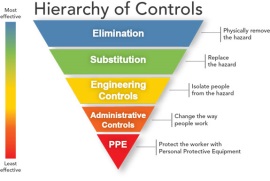
by Brianna Crandall — February 25, 2015—The Centers for Disease Control and Prevention’s (CDC) National Institute for Occupational Safety and Health (NIOSH) launched publications in recent weeks dealing with engineering controls, reproductive risks, and protecting healthcare workers from workplace violence, described briefly below.
The new Engineering Controls Directory Page features resources, tools, and information related to engineering controls, including a list of hazards where these barriers are effective to reduce or eliminate occupational hazards, and a list of related topic pages. According to the new page:
Engineering controls protect workers by removing hazardous conditions or by placing a barrier between the worker and the hazard. Examples include local exhaust ventilation to capture and remove airborne emissions or machine guards to shield the worker. Well-designed engineering controls can be highly effective in protecting workers and will typically be independent of worker interactions. They typically do not interfere with worker productivity or personal comfort and make the work easier to perform rather than more difficult. The initial cost of engineering controls can be higher than some other control methods, but over the longer term, operating costs are frequently lower, and in some instances, can provide a cost savings in other areas of the process.
NIOSH also published a Federal Register Notice: NIOSH Current Intelligence Bulletin: Reproductive Risks Associated With Hazardous Drug Exposures in Healthcare Workers and Recommendations for Reducing Exposures, which announced the availability of a draft Current Intelligence Bulletin now available for public comment. To view the notice and related materials, visit Regulations.Gov. Electronic or written comments must be received by March 24, 2015.
A new NIOSH Science Blog: Can Workplace Exposures Increase Risks of Birth Defects? – Epidemiology in Action addresses the occupational hazards for pregnant and breastfeeding women in light of the fact that occupational exposure limits are based on studies of healthy, non-pregnant workers, and many early studies of occupational hazards were limited to men. These recommended exposure limits might not be sufficient to protect a developing fetus, according to NIOSH. The agency is trying to find out whether things people were exposed to at work like chemicals, noise, shift work, radiation, or germs affect their pregnancy outcomes and health of their children, with a particular focus on birth defects.
Online Training Helps Protect Nurses and Other Healthcare Workers from Workplace Violence – DHHS (NIOSH) Publication No. 2015-118 addresses the issue of protecting healthcare workers, who dedicate their lives to the treatment and care of patients and sometimes put their own safety and health at risk to help a patient or visitor. NIOSH offers an online Workplace Violence Prevention for Nurses course for healthcare professionals.





